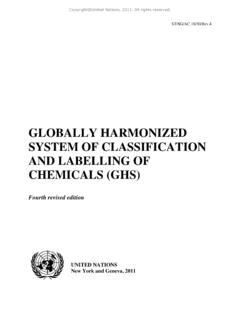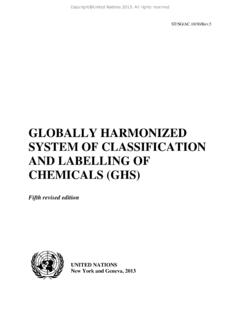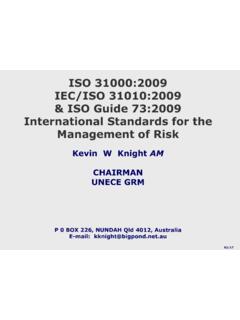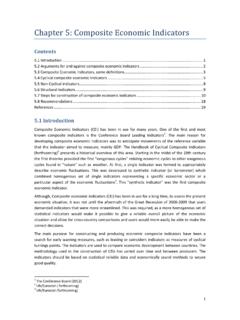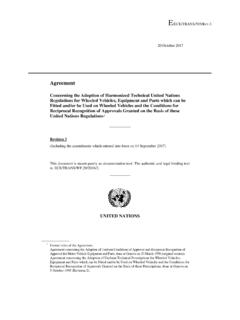Transcription of Recommendation 21 - UNECE
1 Recommendation 21 CODES FOR TYPES OF CARGO,PACKAGES AND PACKAGING MATERIALSWITH COMPLEMENTARY CODES FOR PACKAGE NAMESR ecommendation , adopted by the Working Party onFacilitation of International trade Procedures, Geneva, August 1994 ECE/ trade /195. [Edition ]The Working Party on facilitation of International TradeProcedures, a subsidiary body of the United NationsEconomic Commission for Europe, agreed to include inits programme of work in 1976 a project to specify varioustypes and methods of packaging with a view to thesubsequent creation of codes for names of packages mostfrequently used in trade .
2 The aim was to provide a linkbetween documents and goods and facilitate the identifi-cation of goods and other cargo handling operationsduring that other international bodies, such as the UN/ECE Inland Transport Committee, the European Eco-nomic Community (EEC), the International Chamber ofShipping (ICS) and the International Union of Railways(UIC) also had a strong interest in and had undertakenwork on this subject, the UN/ECE Working Party in 1981invited the secretariats of all interested internationalorganizations to examine the various concepts and tocollaborate to harmonize the different codes.
3 Afterextensive national and international consultation andcollaboration, in 1986 a final project was transmitted tothe Working Party which at its twenty-third session inMarch 1986 agreed to adopt the appropriate its thirty-ninth session (March 1994), the WorkingParty agreed to approve the proposal made by the delega-tion of Canada in document toincorporate, as an additional annex, the packaging codesused for the transportation of dangerous goods into theRecommendation and to amend it Working Party on facilitation of International TradeProcedures,Bearing in mind the rapid and accelerating pace of theintroduction of new transport and data processing tech-niques and urgent need to adapt trade procedures to suchnew techniques.
4 Noting that there is a need to harmonize existing expres-sions and codes used in international trade procedures todescribe and represent different types cargo, packagesand packaging materials;Recommends Governments and organizations responsi-ble for relevant national regulations and practices relatedto the movement of goods in international trade to supportinternational facilitation work by considering the codesdescribed in the present Recommendation with a view tointroducing them in such regulations and in practice;Recommends organizations responsible for internationalinstruments that contain codes such as those covered bythe present Recommendation to consider harmonizationof any such codes in accordance with those presentedhereafter when reviewing existing or preparing newinternational provisions;Recommends participants in international trade to use,as required, the numeric codes presented in this recom-mendation when there is a need for such codes in tradeprocedures to represent different types of cargo, pack-ages, and packaging materials.
5 Recommends participants in international trade to use,as required, the complementary alphabetic codes pre-sented in this Recommendation when there is a need forsuch codes in trade procedures to represent names ofpackages;Invites Governments and international organizationsconcerned to notify the Executive Secretary of the Eco-nomic Commission for Europe of the extent to which theyare able to harmonize the relevant codes for which theycarry responsibility or to communicate the reasons forbeing unable to do the thirty-ninth session of the Working Party represen-tatives attended from.
6 Austria, Belgium, Bulgaria, Canada,Croatia, Czech Republic, Denmark, Estonia, Finland,France, Germany, Greece, Hungary, Iceland, Ireland,Israel, Italy, Malta, the Netherlands, Norway, Poland,Romania, Russian Federation, Slovakia, Slovenia, Spain,Sweden, Switzerland, Turkey, United Kingdom of GreatBritain and Northern Ireland and the United States ofAmerica. Representatives from Australia, Brazil, Gabon,Japan, Korea, New Zealand, Nigeria and Senegal partici-pated under Article 11 of the Commission s terms session was attended by representatives of the Euro-pean Union (EU).
7 263 Recommendation 21 Codes for Types of Cargo, Packages and Packaging Materials264 Recommendation 21 The session was also attended by representatives of thesecretariat of the United Nations Conference on Tradeand Development (UNCTAD), the United Nations Com-mission on International trade Law (UNCITRAL), andthe International trade Centre UNCTAD/GATT (ITC),as well as by representatives of the following intergovern-mental organizations: Universal Postal Union (UPU),European Free trade Association (EFTA), Central Officefor International Railway Transport (OCTI) and CustomsCo-operation Council (CCC).
8 The followingnon-governmental organizations were represented:Comit International des Transport Ferroviares (CIT),International Air Transport Association (IATA), Inter-national Article Numbering Association (EAN), Interna-tional Express Carriers Conference (IECC), Interna-tional Road Transport Union (IRU), International Cham-ber of Commerce (ICC), International Organization forStandardization (ISO), International Union of Railways(UIC), Society for Worldwide Interbank Financial Tel-ecommunication ( ), Union des Administra-tions Portuaires du Nord de l Afrique (UAPNA).
9 Alsopresent at the invitation of the secretariat were repre-sentatives of the Taipei EDIFACT Committee, SITPROSA( trade facilitation Committee of the Republic of SouthAfrica) and International Federation of Inspection Agen-cies (IFIA).I. trade implies the movement of goodsover international boundaries. For several reasons thesegoods need to be described and identified while they arebeing moved. Identification marks ( shipping marks )are essential for this purpose and descriptions of thenature of the merchandise may also be helpful. But theappearance of the goods as presented for transport is avery useful means to identify them and is also of vitalimportance for handling operations, for planning andstatistical recording of such operations and as a basis forthe establishment of freight and cargo handling harmonization of expressions and concepts usedto describe and identify goods and cargo moving intransport has been recognized as a problem that needsattention within the framework of the international workon facilitation of trade procedures.
10 It is recognized thatvaluable work has already been undertaken by unimodaltransport operators and by some official regulatory agen-cies responsible for health and safety standards in trans-port of certain products ( food, plants, drugs, danger-ous goods and hazardous wastes). But these have beenindependent efforts and there is at present a number ofnon-harmonized terms and codes for loads, packagingsand other modes of appearance of goods in transport andtransport-related operations. This lack of harmonizationhas caused difficulties, for consecutive cargo operationsby different modes of transport as well as for the forward-ing and packaging industries and the recording of statis-tics on international trade and computerization of transport procedures hasfurther increased the need for harmonization.


